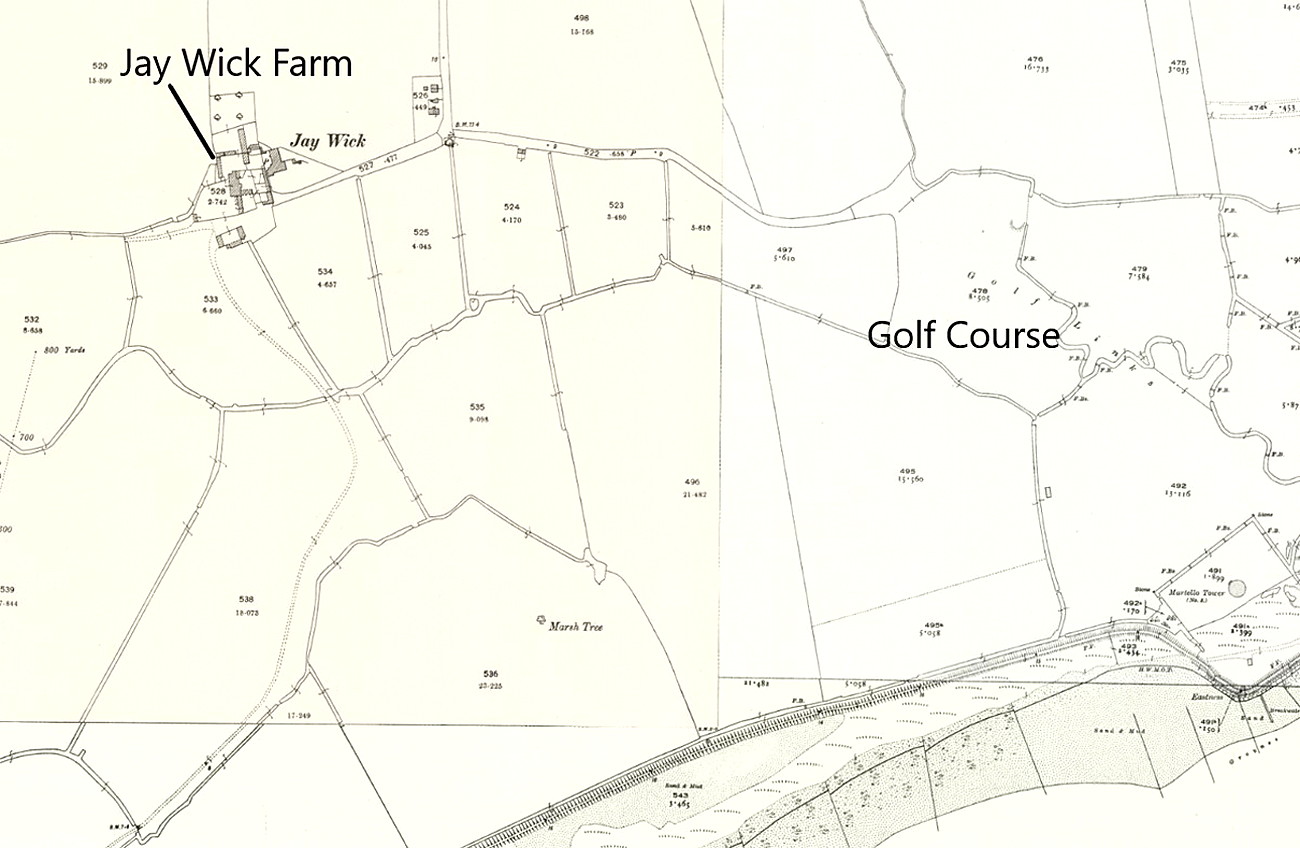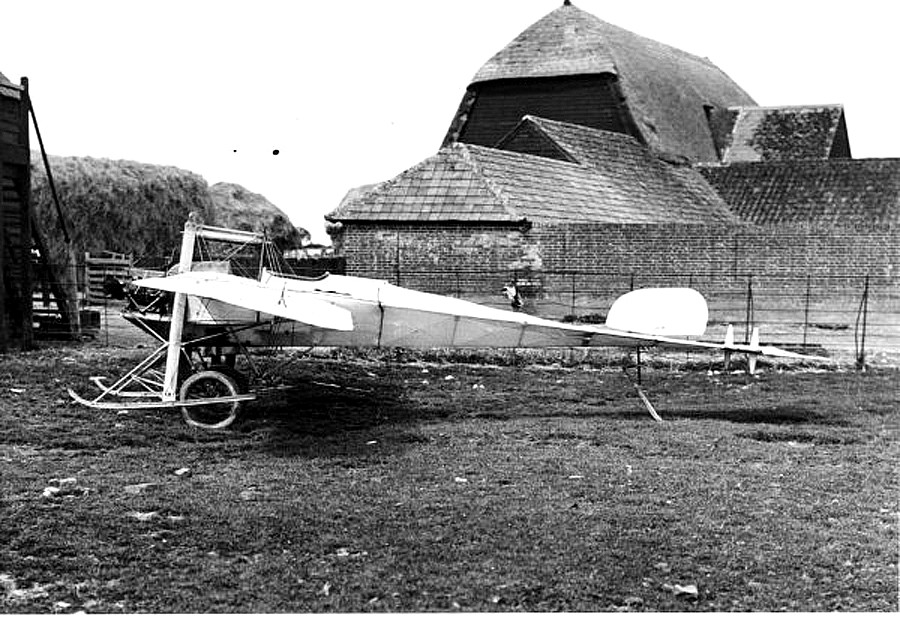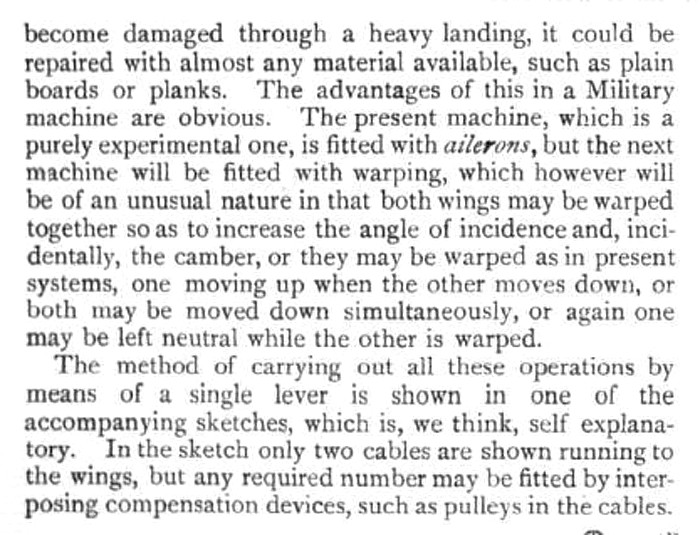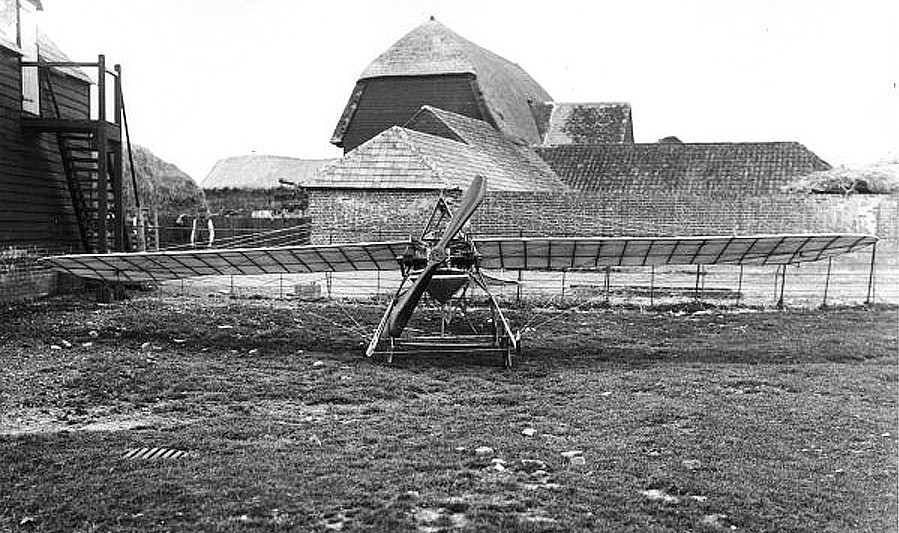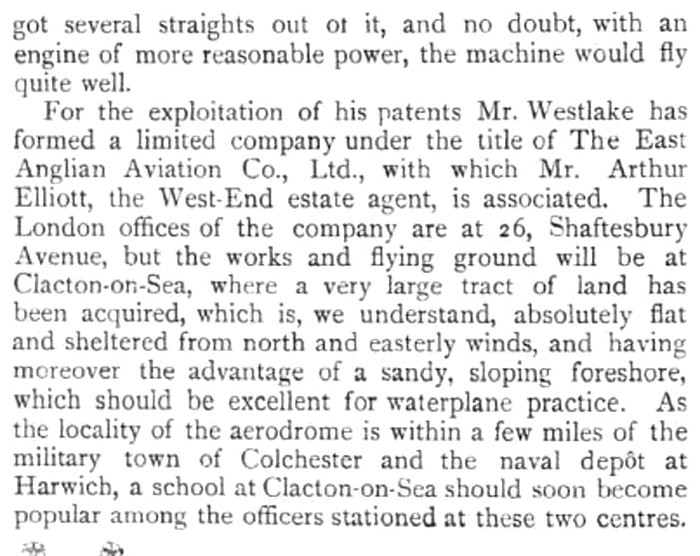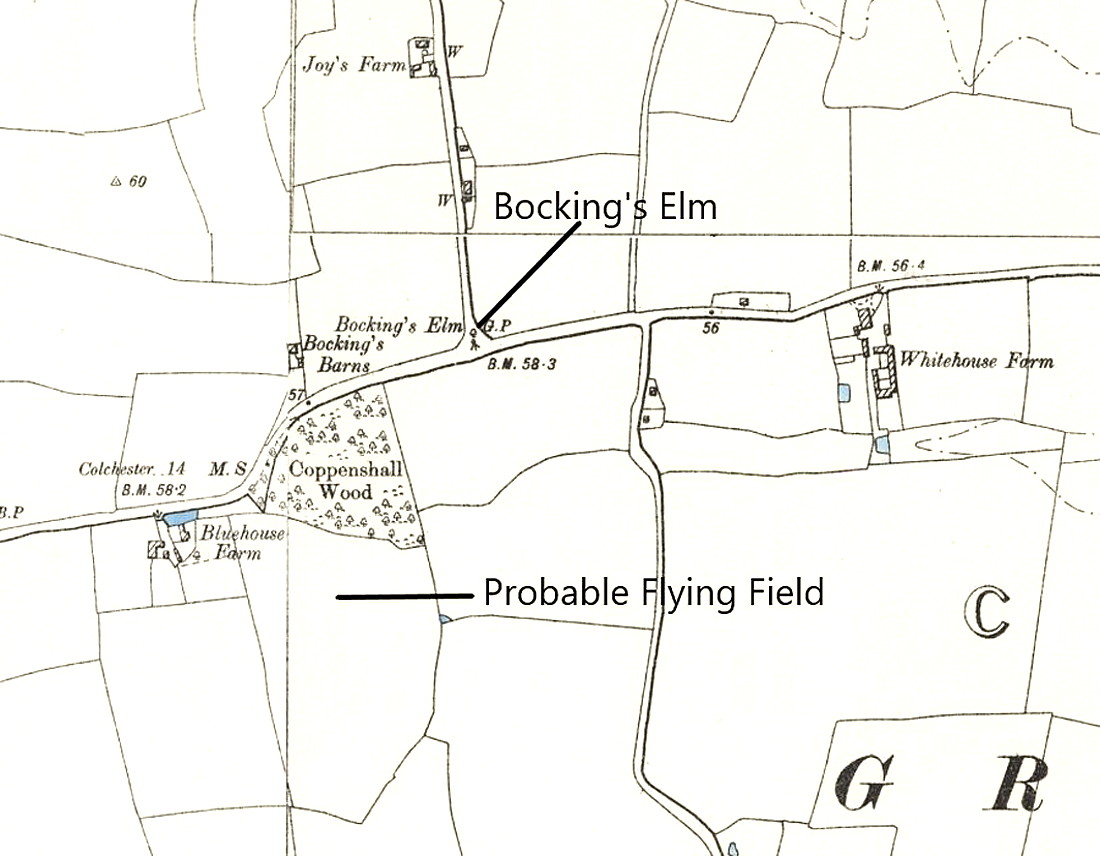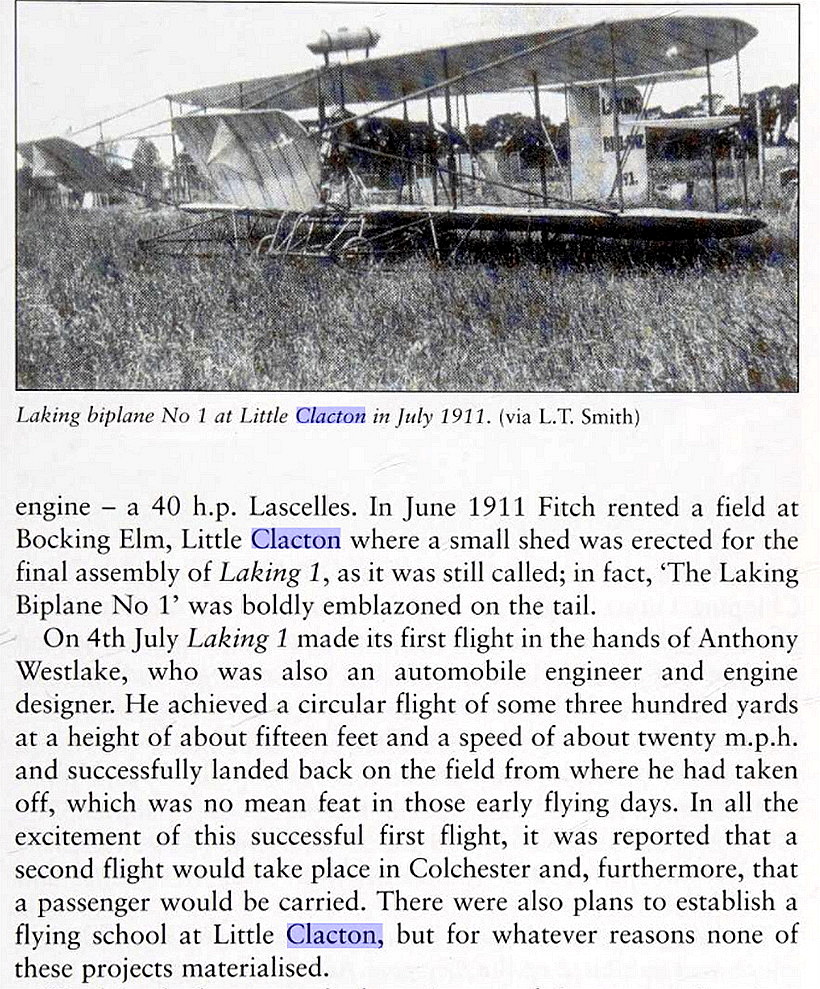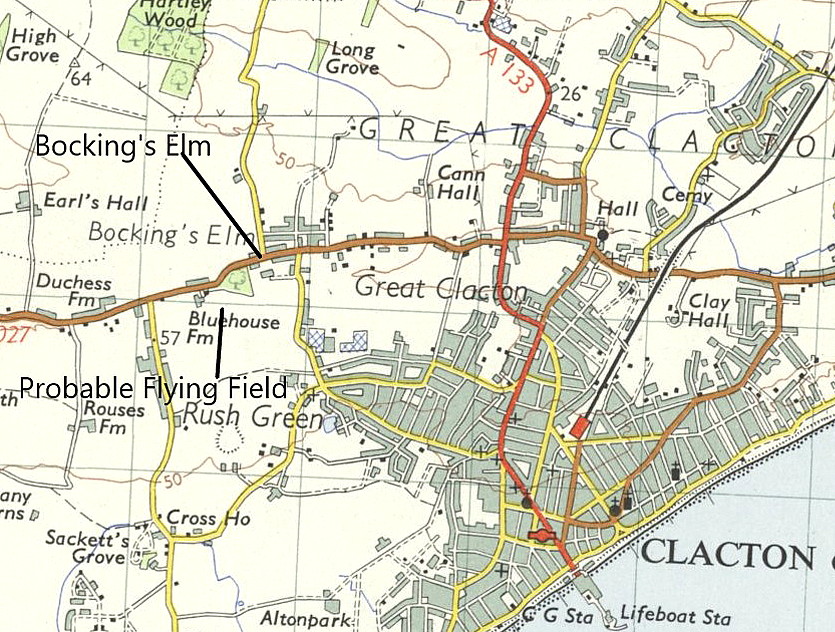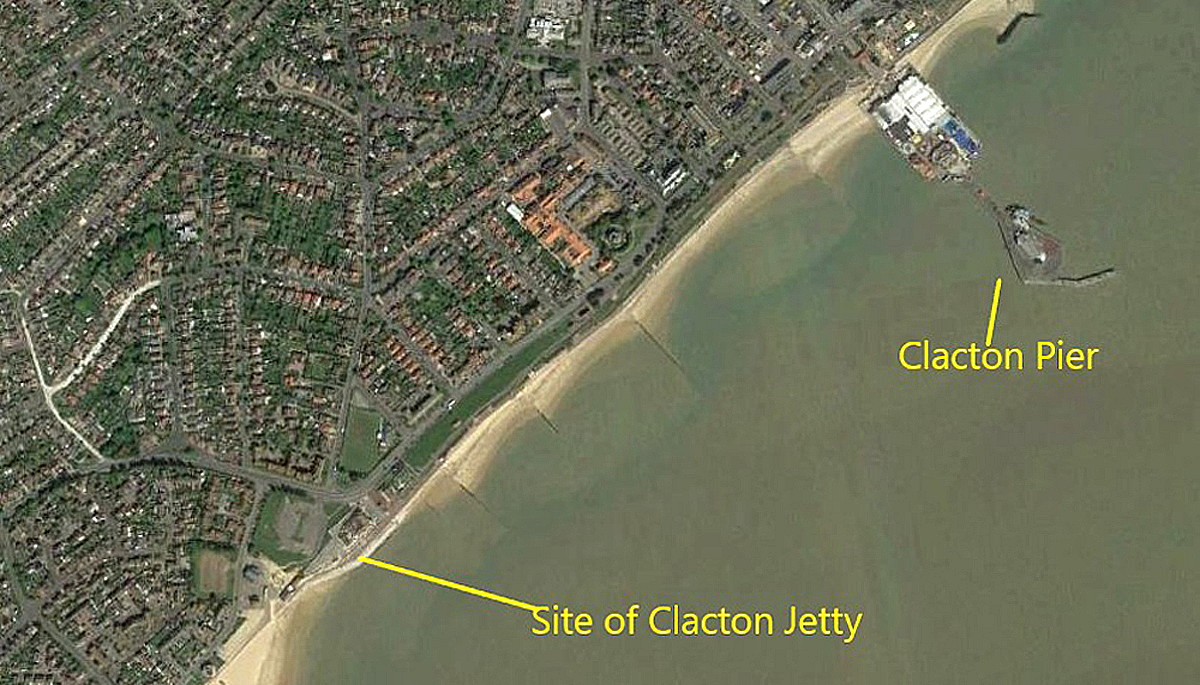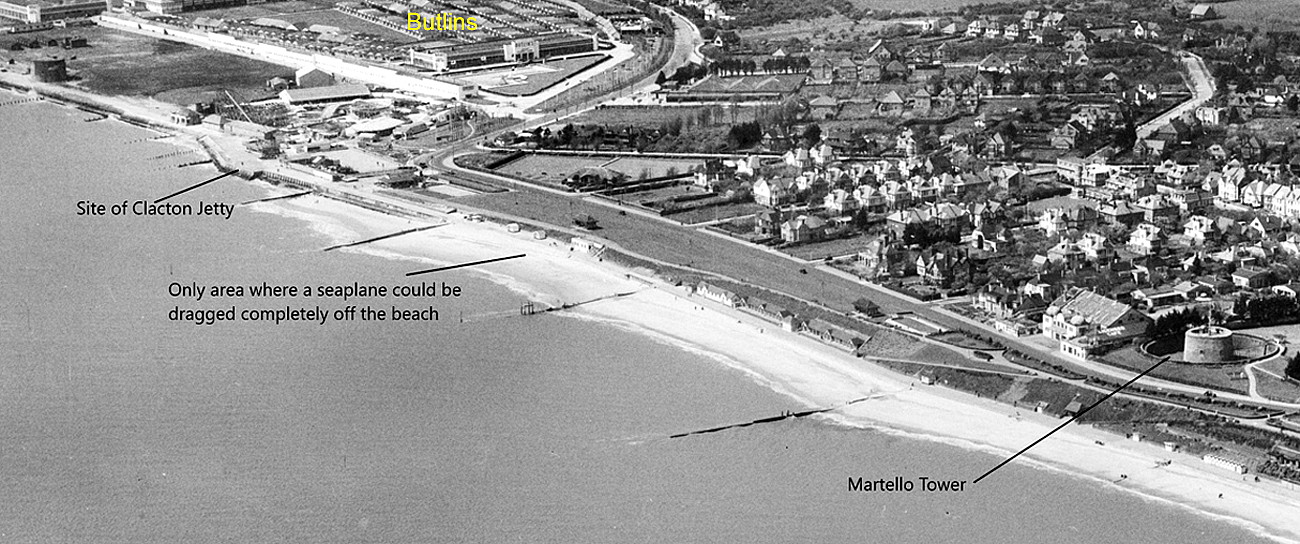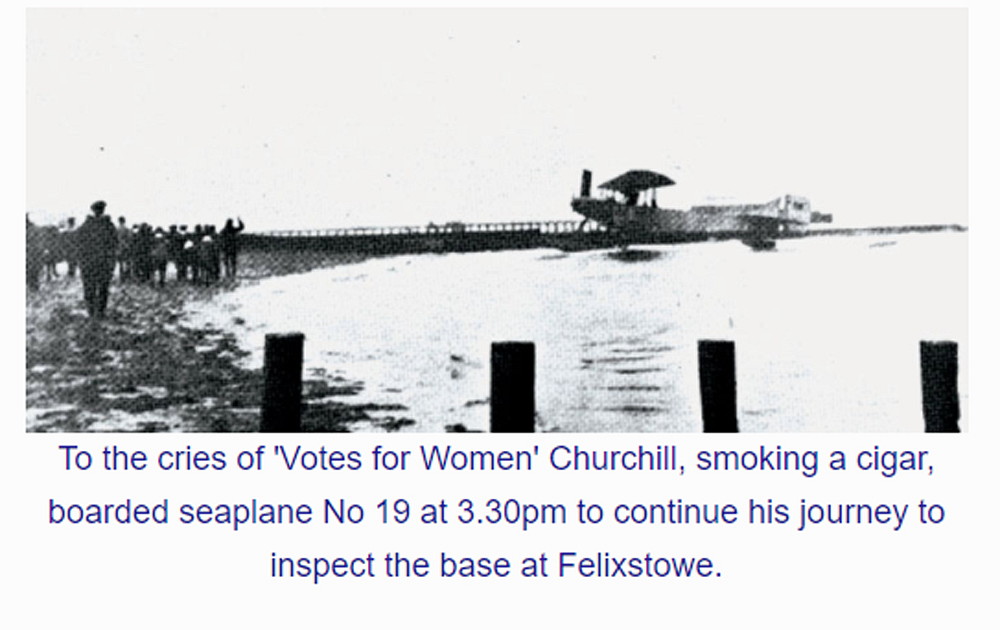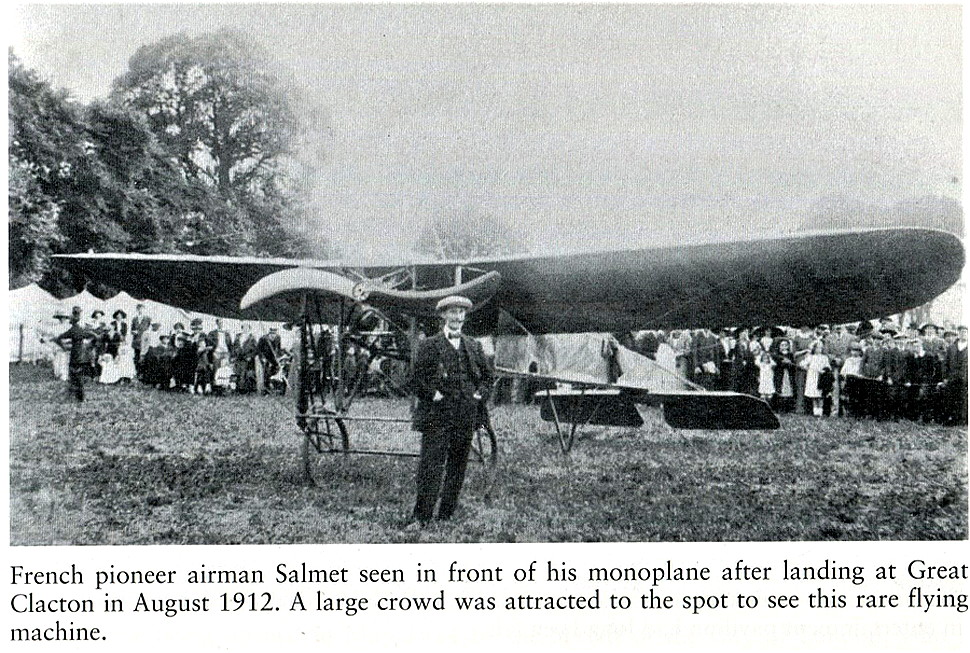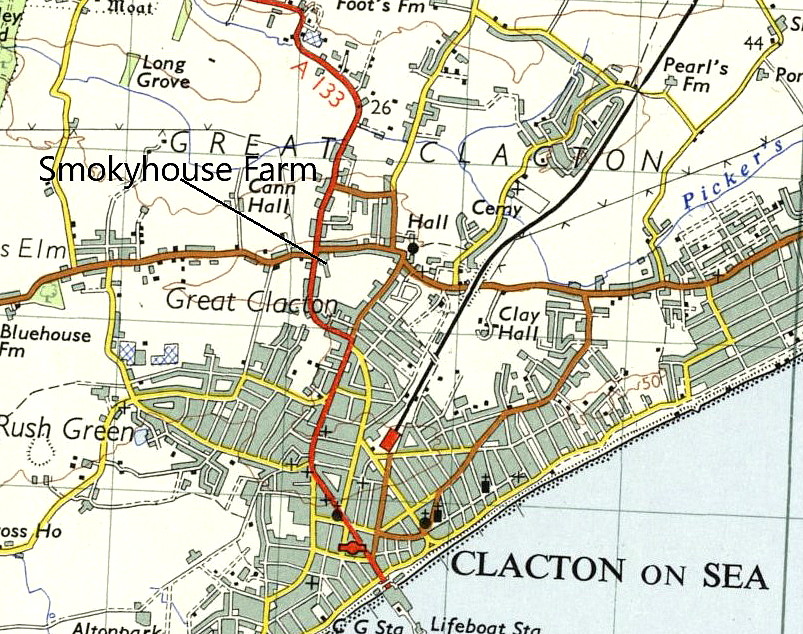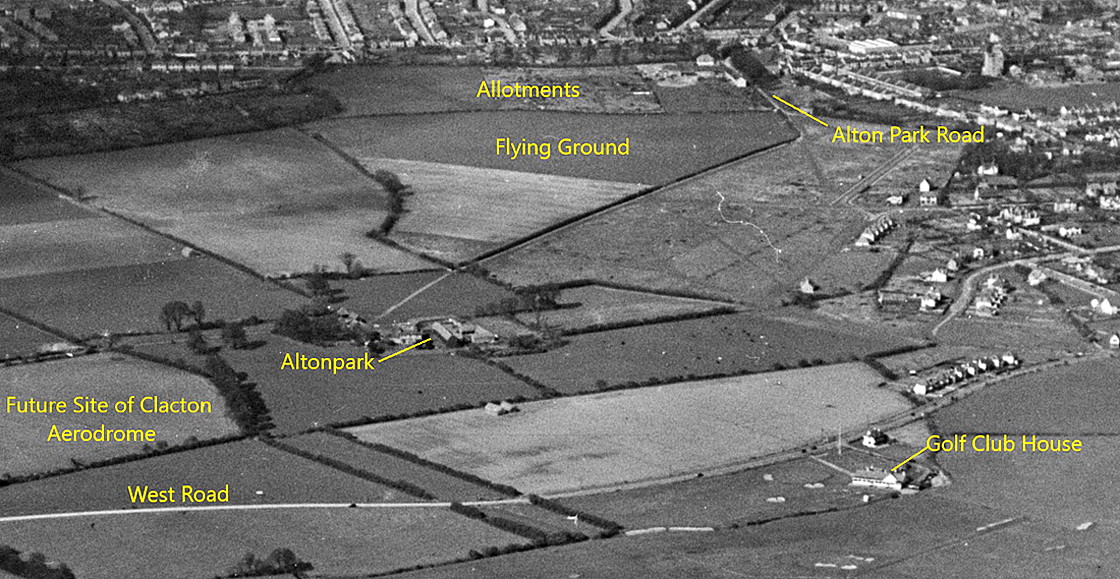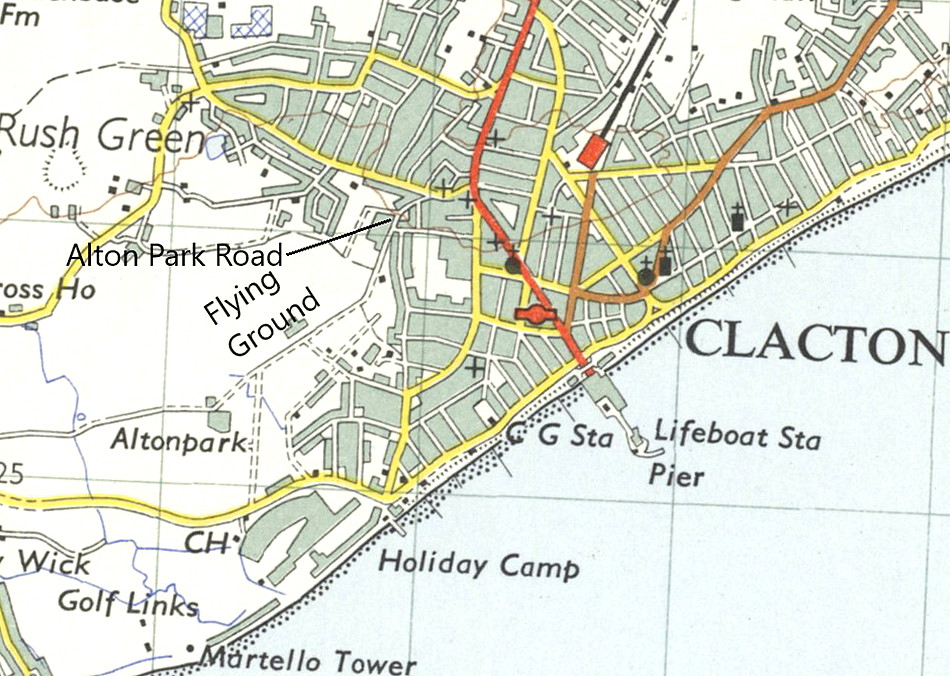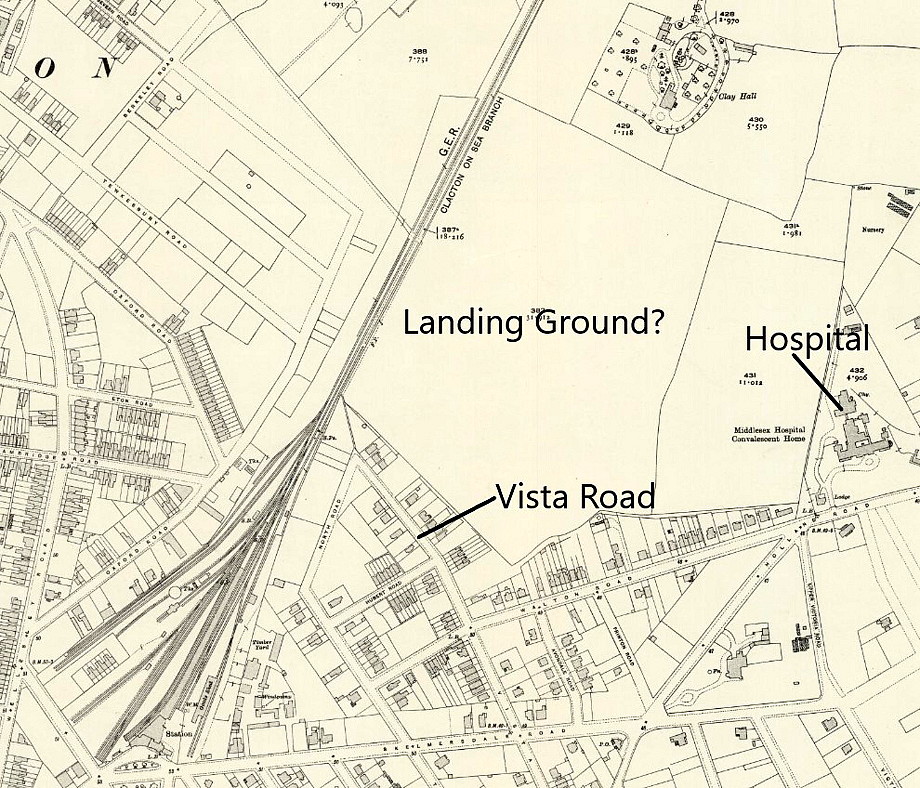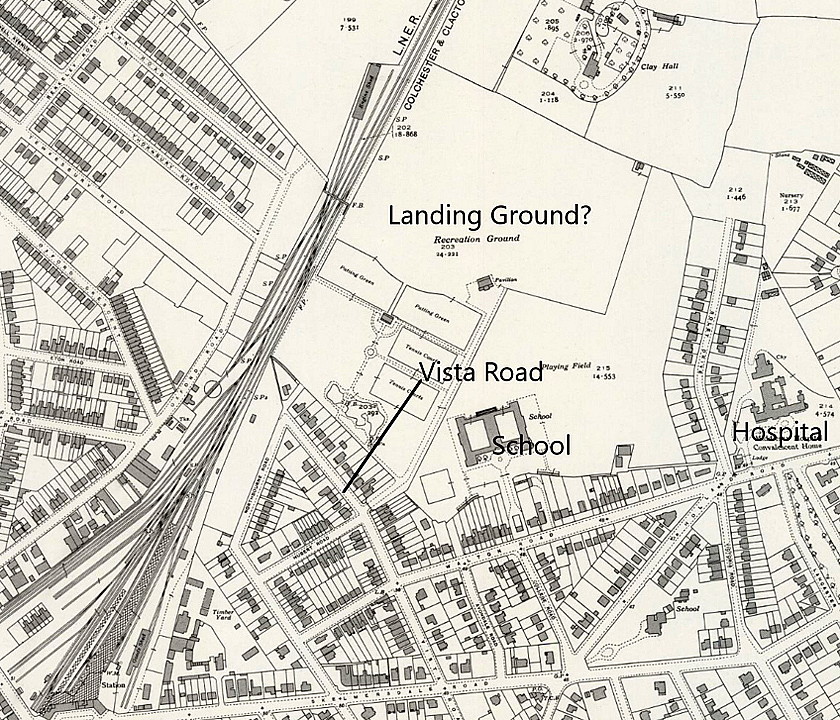Clacton-on-Sea flying sites
Note: This map only gives the location of Clacton town within the UK.
CLACTON see also JAYWICK
CLACTON see also PLOUGH CORNER
CLACTON-ON-SEA: Early experimental flying sites
Operated by: Mr A Westlake at JAY WICK and Mr Lake at BOCKING'S ELM
These two maps, kindly provided by Mr Mike Holder, show the BOCKING'S ELM location in the first map, and the JAY WICK location in the second map.
Locations: Bocking's Elm was near Little Clacton which is situated just NW of Clacton-On-Sea town centre. The JAY WICK location was to the SW of Clacton town centre
Period of operation: 1909 to 1913 only?
NOTES: It is recorded that Mr G F Lake designed a monoplane at Clacton in 1909, constructed by a firm of local motor engineers, Fitch and Son. Whether it hopped or let alone flew seems lost in the mists of history. In C C Turners Old Flying Days published in about 1927 he lists this person as being a Mr G Laking. It now appears he, (and others), may have been a bit confused on the issue because Ron Smith in his excellent British Built Aircraft Vol.3 has this information:
“The Fitch biplane of 1911 was a re-engined version of the unsuccessful Laking biplane of 1909. British Aircraft Before The Great War records that this aircraft was flown from a field at Little Clacton by Mr A Westlake on the 4th July 1911, completing a short circular flight."
On the other hand Mr A Westlake of Clacton appears to have designed a monoplane powered by his 18hp horizontally opposed engine and built by the East Anglian Aviation Co. Ltd situated “next to the waterfront” in Clacton during 1913. It seems that several ‘straights’ (flights in a straight line), or “extended hops” were achieved but the 18hp engine precluded advancing the type further. Ron Smith makes two interesting comments; firstly that – “This machine had every appearance of having great potential given a more powerful engine.”
A MICHAEL T HOLDER GALLERY
Note: The excerpt is from an account published by the Jaywick Local History Society.
THE ILLUSTRATED ARTICLE IN FLIGHT MAGAZINE
We have Mr Mike Holder, a great friend of this 'Guide' to thank for finding these pictures of the Westlake monoplane, plus the lead picture of Mr Westlake standing in front of his machine. These were published, with the article, in Flight magazine on the 13th September 1913. The fourth picture clearly shows the wingtip ailerons.
MORE INFORMATION AND COMMENTS
“After initial trials with ailerons, it was reported that the machine was to be converted to wing warping.” Today this comment may well appear utterly incongruous but we need to remember that ‘basic’ ailerons where one went up by exactly the same amount as the other went down invariably resulted in an out-of-balance situation unless counteracted by fairly skilful use of the rudder which often had to be applied before the ailerons could be used. Indeed, use of ailerons alone, on some older types I’m told, can result in a skidding turn in the opposite direction!
It is often said that once ‘differential’ ailerons were invented the need to use the rudder was pretty much eliminated and pilots of older aircraft often complain that modern pilots don’t know what their feet are for. Typically there is a degree of truth in this but anybody flying, for example a typical light Cessna or Piper type, will quickly appreciate just how quickly a ‘bootful of rudder' will enhance the rate of roll and rate of turn. It’s a great shame the designers of early Airbus airliner types didn’t realise this - if they had the tragedy over New York shortly after 9/11 might well have been prevented.
SOME EXTRA INFO
Mike Holder has kindly looked further into this subject, and provides us with these items regarding BOCKING'S ELM.
Note: The second item is an excerpt from Essex and its Race to the Skies, by Graham Smith.
CLACTON: Seaplane Station
A MICHAEL T HOLDER GALLERY
Note: The third item is from Essex, A Hidden Aviation History.
Note: The sixth item is from, Essex Heritage Gateway. The local area view is from my Google Earth © derived database.
Military user: RNAS (Royal Naval Air Service)
Location: Seafront near and W of Clacton town centre, between the pier and landing stage
Period of operation: 1914 to 1916
NOTES: On a one-off visit to Clacton in July 2013 I came across a photograph of a floatplane on the beach. It was on an information board in one of the gardens near the pier; namely the 1920s garden. The caption states that on the 30th April 1914 Winston Churchill, First Lord of the Admiralty, had an engine failure and force landed at Clacton. This would have been before hostilities commenced, leading to WW1 (The Great War) on the 28th July 1914.
A search of the internet reveals that Churchill did undertake some flying training which he much enjoyed. Presumably this training was with the Royal Navy Air Service but, he never gained his license, although getting close it appears and, due to his very senior rank it would seem somewhat unlikely he was allowed to fly solo? It also appears his wife persuaded him to stop flying and quite possibly this incident increased her anxiety.
Perhaps it is also just conceivable that this forced landing led the military authorities to consider the suitability of the seafront at Clacton as a Seaplane Station?
A MICHAEL T HOLDER GALLERY
Mike Holder is a great friend of this 'Guide' and has unearthed no end of information, including in this case, that it now appears that the information I saw on the information board is incorrect. That incident involving Churchill, as both passenger and perhaps student pilot under supervision (?), making a precautionary landing here, was on the 24th April, not the 30th. It is only a guess on my part, but possibly, the two aircraft involved were the Short S.41 type?
Note: The second item, a photo, is from Essex and its Race for the Skies by Graham Smith. The third item was published in the Hampshire Telegraph on the 1st May 1914.
Note: This fourth item is from Greensward Cafe co.uk.
Clearly the precautionary landing was on the north side of the jetty, whereas the aircraft used to take Churchill onto Harwich landed on the south side of the jetty. The fifth item was published in the Derby Daily Telegraph on the 24th April 1914.
Churchill remained a keen supporter of aviation and indeed, in January 1942 took the decision to return by air in the Boeing 314a Clipper RMA Berwick from Bermuda to the UK – an eighteen hour flight. It appears that many were much against this decision but it did save a week at sea which in those days was arguably equally perilous. The Germans found out about the flight and sent aircraft out to shoot the Clipper down – but they couldn’t find it and Goering was furious.
A photograph exists of Churchill, cigar in mouth of course, sitting in the Captain’s seat of the Clipper but this was almost certainly a publicity shot?
CLACTON - Temporary Landing Ground
The then famous French aviator Henri Salmet, visited Clacton-on-Sea on the 8th to 10th August 1912. He was being sponsored by the Daily Mail to undertake a Tour of England and South Wales. It is not known (?) exactly where he landed and gave 'exhibitions of flying' from, but it could well have been the location listed below - ALTON PARK ROAD.
Notes: The photo is courtesy of Britain in Old Photographs. The short article was published in the Essex Newsman on the 17th August, and the excerpt in John Bull on the 24th August 1912.
These three items have been kindly provided by Mike Holder.
CLACTON - SMOKYHOUSE FARM: Temporary Landing Ground
It appears that Henri Salmet came back to Clacton-on-Sea on the 22nd August 1913, and performed from a field at SMOKYHOUSE FARM in Great Clacton. It is not known (?) which field, but without much if any doubt, one of the largest fields shown on the map and aerial photo below.
Note: The maps and Google Earth © views are kindly provided by Mike Holder, as is the third item. This was published in the Eastern Counties' Times on the 29th August 1913. The last item, the local area view, is from my Google Earth © derived database.
CLACTON - ALTON PARK ROAD: Civil aerodrome
(Aka ALTON PARK, CLACTON FLYING GROUND and ALTONPARK - spelt as one word)
(See also listing for PLOUGH LANE)
Location: Just W of Clacton-on-Sea town centre
Period of operation: Unknown? Possibly from the early 1920s(?) until 1938/9(?)
A MICHAEL T HOLDER GALLERY
Note: The second item, an advert, was placed in the Suffolk and Essex Free Press on the 23rd August 1928.
Note: The fourth item is an advert produced by Hillman's Airways to give notice of the service from MAYLANDS (ESSEX) to Clacton, starting from the 1st April 1932.
NOTES: In 1932 Hillman's Airways started a ROMFORD (MAYLANDS) to CLACTON service using a de Havilland DH80A Puss Moth and a de Havilland DH83 Fox Moth. The return fare was £1 and a single 12s/6d. In the early 1920s at least it is said that a Mr Sam Summerfield made a living with an Avro 504K offering ‘joy rides’ along the east coast and was often flying from CLACTON. Did he use the same site perhaps? In the 1935 summer season Crilly Airways were also operating a CLACTON-SOUTHEND-MARGATE service with one de Havilland DH84 Dragon operating on Sundays only.
It now appears Hillman’s Airways used ALTON PARK in 1932 but moved to EARLS HALL FARM in 1933. It is also said they used a location at VISTA ROAD, see below.
AIRLINE PASSENGER CAPACITY
Is it not quite astonishing today, to learn that it was then (in 1932) considered a perfectly reasonable, and viable commercial venture, to start a regional airline service with an aircraft which could carry, at best, three adult passengers? The DH Fox Moth did of course have four seats, but, to fit four adults in they would need to have been small in stature.
But of course, at that time other ‘airline’ services sometimes operated ‘single’ passenger services, usually with a DH.60 Moth. This was during the height of the ‘Great Depression’, (or ‘The Great Slump’), with 3.5 million unemployed in the UK and many others on part-time work. It certainly seems to serve the argument that the ‘Depression’ only really affected the working classes? And even then it was patchy mostly inflicted on the industrial areas, mostly in ‘The North’.
It seems worth reflecting on that the working classes in the worst hit areas put up with immense privations for years. For example it wasn’t until October 1936 that the famous ‘Jarrow March’ occurred when thousands of starving workers in the north-east decided to take their desperate plight to London and parliament – on foot. I cannot recall seeing pictures of pitiful stockbrokers begging on the streets of Sunningdale or Ascot during this period. Indeed, arguably the most luxurious British airliner type of the inter-war years, the Short 'C' Class 'Empire' flying boat, first flew on the 3rd July 1936.
A JOLLY DAY OUT
According to Neville Doyle, also in 1932: “On Sunday 14th August, it was reported that “forty people from the Mount Pleasant Office of the GPO, (My note: Situated roughly a mile SE of Kings Cross station in London), including several women had a novel outing to Clacton by air. They travelled from Romford in five Hillman aircraft and returned the same way.” This takes a bit of thinking about – forty people being flown in three seater Puss Moths and four-seater Fox Moths. They must have been operating a shuttle-service pretty much dedicating the entire day to this enterprise. An advert for Hillman’s Airways in October 1932 gave the return air fare to Clacton as £1.0.0. Incidentally,Hillman Airways who were the 'launch customer', couldn't have been operating the DH Dragon as the first flight of this 'airliner' took place on the 12th November 1932.
A FLYING CIRCUS VENUE
It appears that when Sir Alan Cobham's National Aviation Day display tour reached Clacton on the 26th July, the venue was ALTON PARK ROAD. Sometimes confused, even by serious experts, with PLOUGH CORNER.
CLACTON: Temporary aerodrome?
NOTES: Clacton was the venue on the 28th May 1933 for Sir Alan Cobham’s No.1 Tour. Did they use ALTON PARK ROAD, PLOUGH CORNER, EARLS HALL FARM or another location?
CLACTON, VISTA ROAD
Note: In response to the 'Comment' below by Mr Bernard Mann, in March 2023 Mike Holder kindly looked into this. Without much if any doubt, as the maps above show, the location perhaps sometimes used by Hillman's Airways, was just north of Clacton town centre and if anything just to the east.
CLACTON-ON-SEA: Military airstrip
Military user: US First Army 32nd Field Artillery Brigade, 987th Field Artillery Battalion
Location: ?
Period of operation: 1944/5 only?
NOTES: It appears that two Piper L-4 Grasshoppers were based here. Possibly using either PLOUGH CORNER or EARLS HALL FARM?
Bernard Mann
This comment was written on: 2018-03-24 16:32:05Hello, my Great Uncle Phineas Headworth travelled to Clacton from London on many occasions using Hillman’s Airways. He embarked at Maylands, Romford and told me many years ago that the plane landed at what is now Vista Road playing fields just to the west of the town. Have you any knowledge of that ever being an airstrip.
Reply from Dick Flute:
Hi Bernard, Many thanks indeed. I have no information about this location being used as a flying site. I shall keep this posted and hopefully somebody can kindly offer advice. Best regards, Dick
We'd love to hear from you, so please scroll down to leave a comment!
Leave a comment ...
Copyright (c) UK Airfield Guide





















